Natural slate is a material that has been embraced as a way to improve any premises, whether it be with landscaping, roofing or interior improvements. Few materials will surpass the inherent beauty of natural slate tiles, and it’s not even limited to domestic uses only.
Using slate, whether in your home or commercial property, can give you a lot of benefits. After all, this stone can be used for the outside, such as for the exterior walls of your home or the roof, or indoors to create a beautiful design you can be proud of at all times.
Slate is a highly versatile stone capable of being used in an extensive range of applications, and it’s widely regarded as a natural stone that offers sophistication and style to any design. One of slate’s most remarkable features is its ability to be adapted and worked to your specific needs, meaning you can add a unique, authentic look to your home or business if you opt to use this natural stone.
At UK slate, we embrace the beauty that natural slate provides while working to ensure that our customers are able to implement their slating in the exact way they wish. There are plenty of options when choosing a natural slate. This versatile material can be manipulated into many sizes and be supplied in a variety of colours.
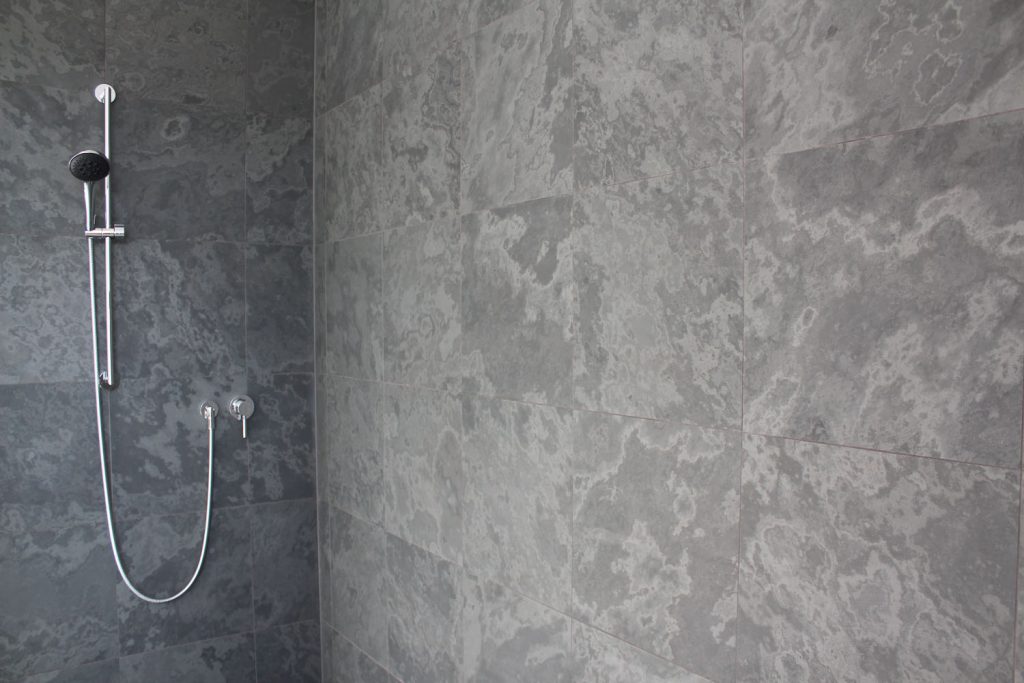
This natural stone can provide beautiful designs that add style and beauty to any room – however, this feature begs the question, ‘what makes slate so aesthetically pleasing?’ Its natural appeal, as well as the honing process it goes through, greatly contributes to this characteristic.
When the tiles are machined to a honed flat finish, the process involved cuts through the minute undulating layers within the slate and can create a billowing cloud effect. This is because the honing procedure enhances the variations of shade within the stone, sometimes leaving plain tiles, other times beautiful swirling patterns that are unique to each tile. This flexibility is perfect for creating a wide array of designs, whether you intend for them to lean towards the traditional or the contemporary style.

This capacity to create bespoke designs is what makes slate one of the best materials to work with and why one of our customers chose to use it in one of their latest projects in Central London, in which they undertook a complete bathroom and wetroom designed by an internationally renowned Japanese architect.
We used Elterdale Grey Green Honed Slate in a 400mm x 400mm format so that the tiles, both on the shower walls and the bathing area, had a smooth, matt surface with natural colour variations to them. For the base of the shower area, they used the same Elterdale Grey Green slate but in a Riven finish, which has a natural hand-split texture. This was to give a contrast to the different areas within the room but also to provide a safe, slip-resistant finish underfoot.
In order to meet the client’s very specific requirements and timescales we decided to take advantage of slate’s inherent properties, such as its durability and versatility, we ensured that the bathroom would be completely unique in appearance. We also hand-produced special rounded edge tiles for around the inset bath surround. Therefore ensuring a unique finished effect whilst providing clean and safe edges around the inset bath.
Slate can be tailored to fit your particular project. It also allows you to choose between an extensive range of styles, as well as shapes and forms, and be guaranteed a stunning and unique design. If you’d like to learn more about our bespoke slate ware and how it can benefit interior spaces such as a bathroom or a roof with our durable ridge tiles, or our Vermont slates, feel free to talk to us on 015395 59289. You can also speak to us to find out more about how our various slates could improve your existing premises.
Slate is an excellent material for your roof tiles. When maintained, it can not only protect your roof but look great at the same time.
So, Learning how to lay slate roof tiles is an important skill when repairing or replacing a slate roof; and, if done correctly, will save you time and money on your roof maintenance. Please read our following guide to learn everything you need to know about laying slate roof tiles. Laying a slate roof can seem like a daunting job, but with careful patience and suitable materials, it can be done efficiently and to a high standard. There are three main steps to follow:

When conducting any roof maintenance, you should always be aware of correct safety procedures. Performing home maintenance without regard for proper safety is a dangerous idea that could lead to personal injury or at least cause more damage to your home.
When working with Roof Slates, you should take time to put protections in place. Scaffolding is the best access method, but keeping the ladder fixed firmly to the side of the house will do if you’re only repairing a small section of your roof. An additional hook ladder would be helpful, but this will be explained later. Having a volunteer spot the bottom of the ladder while you work is essential.
Find some adequate clothing and footwear. Rubber-soled shoes and thick gloves are a good start. In addition, wearing a hard hat and a coat with thick sleeves will give you the best protection in case of any accidents. Purchasing some plastic goggles will also give you excellent eye protection when working with slate.
Slate tiles are incredibly durable but are dangerous to walk across. The slope angle on most roofs means you could easily slip and fall, so you should take care when walking across them. Older slate roofs can be particularly concerning as they may be more fragile.
Having a hook ladder comes in handy here—this type of ladder hooks over the Ridge tiles at the peak of the roof. The hook ladder allows you to distribute your weight between the ladder and the roof. It is essential that you gradually distribute your weight evenly when walking on a roof.

The roof underlay is sometimes referred to as membrane or underlayment. Regardless of the name, they all do the same thing. Essentially your underlay will keep any moisture from penetrating the tiles and entering your building.
You should check the rafters for any old nails or debris that could damage the underlay before your roll it out. Once you are satisfied, you can begin laying your underlay. Start from one side and move across the roof, ensuring it’s flush against the verge. Nailing the start of your roll down will help keep the underlay in place as you move across the roof.
You can nail the underlay again along the middle, but this isn’t strictly necessary. Instead, nail the underlay again once you’ve reached the other side of the roof to secure it in place.

Now you have your underlay in place; you need to place your first battens. You will also need one under eaves slate tile and two full-sized stale tiles to proceed.
Place the battens on the roof but don’t fix them down yet. Then place one of the full-sized slate tiles on the batten and allow a 50mm overhang. Finally, fix the tile to the batten using temporary fixings.
The second batten will go beneath the slate tile near the first batten. Next, place the eaves slate tile into the second batten whilst making sure the eaves slate reaches the bottom edge of the roof.
A third batten is fitted below the top of the slates. Take the other full-sized slate tile and place it centred on the top of the third batten.
By fitting these initial three, you can now calculate your batten gauge. Then, measuring from the top of one batten to the top of the one next, you can figure out where the rest of the battens should go.
To figure out how to set out your tiles correctly, we recommend drawing a chalk line from the ridge to the eaves at the width of every slate. Remember to allow a 5mm gap for the joint between each slate and the battens. This guide will ensure you don’t make incremental mistakes as you make your way across the roof.
It would be best if you lay your under eaves tiles first. Begin with a one-and-a-half slate to create a staggered pattern. Your first fill-length slate should be placed with its tail in line with the under eaves before nailing it in place.
Begin at the bottom and work upwards when placing your slates; bottom right to top left is recommended. This will help you avoid standing on slates as you place them and reduce any risk of slips or breaks.

Slate roofs are popular for many reasons, offering a classic aesthetic alongside an impressively durable lifespan. In addition, they can look vintage while being brand new, an excellent choice for buildings in cities or natural landscapes.
At UK Slate, we specialise in offering a fantastic range of natural slate roofing tiles. In addition, we can import North American, Spanish slates, Vermont slates and Welsh roofing slate and many more. So please get in touch with our expert team to discuss how we can help you with your roof slate needs today.
Slate is an aesthetically beautiful stone that has been used in construction for centuries. They make fantastic roof tiles, able to provide excellent insulation for a home and withstand harsh weather conditions, but they can also be used inside the house as floor and wall tiles. Slate comes in a variety of naturally occurring colours and styles, making it an incredibly versatile material.
But where do these slate tiles come from? How do they go from being mined out of the ground to the tiles on our roofs, wall and floors? Well, here’s what you need to know about the step-by-step process or mining this natural, raw material and turning it into the tiles we know and love.
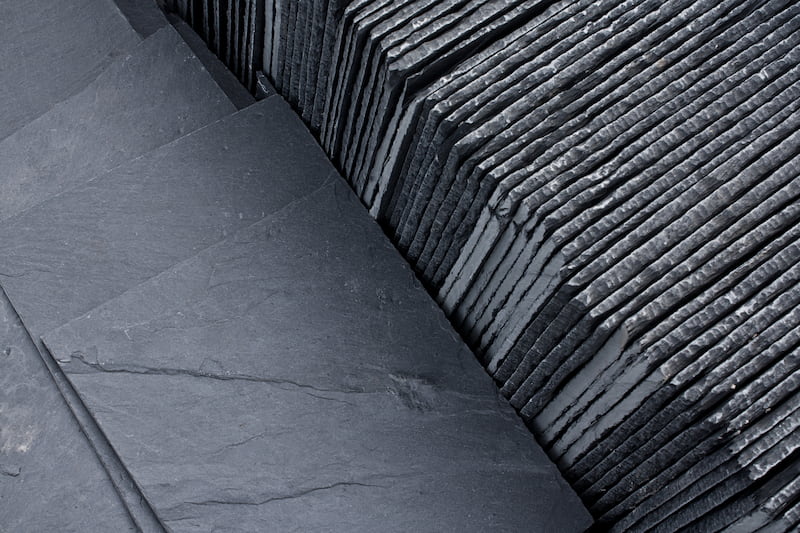
Before the process can begin, quarry sites need to be surveyed and tested to ensure they are appropriate areas to extract the material from. The quarry rocks need to be tested to ensure they are strong enough and suitable for their end-use. The tests are done to discover if there are any weak rock layers that will be detrimental to the stone’s end quality.
The stone will only be extracted from the quarry for use when the tests have verified the quality and purity of the slate.
The raw slate is then sawn from the quarry in large flat slabs using a diamond beaded steel cable – or sometimes detonation is used, but this is done at a minimum to keep slabs large and prevent material loss. The extraction must be done carefully and with precision, as the process can affect the material’s integrity.
Once the slabs are free, they are transported to factories to transform them into tiles.
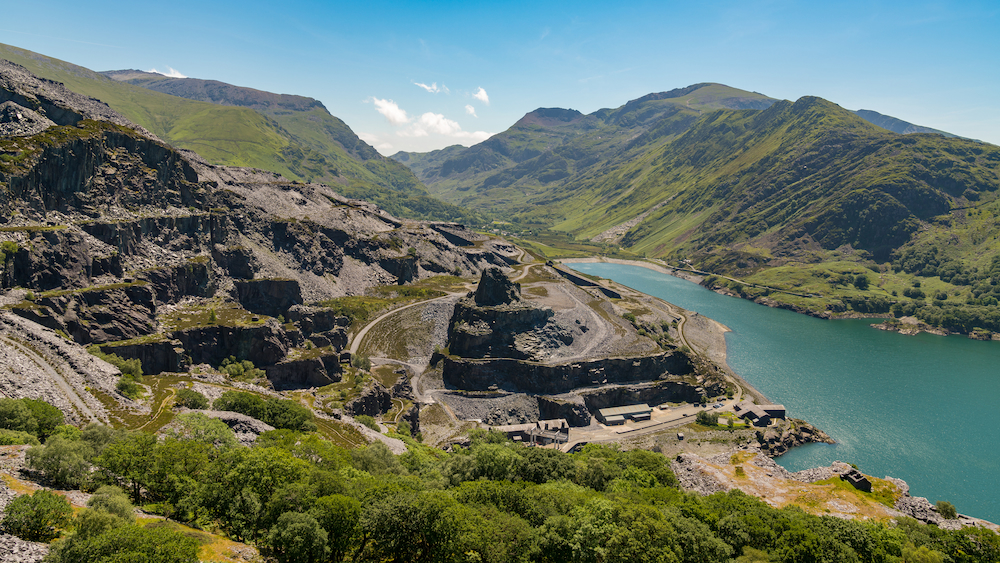
Using diamond-tipped blades, the slabs of slate are then cut into more manageable pieces. During this process, impurities are also removed from the raw material without the use of harsh chemicals. The cuts are then inspected for their end-use. Most slate will be used for roofing, while a portion will be allocated for architectural use. Slate destined for architectural use will need to be of the finest quality and have large dimensions.
The slate cuts are then sent for splitting, where they will be split down to a specific thickness, a process which is done by hand. This technical step of the slate processing process has been done for many centuries.
Splitting is a specialist process that splits the slabs into the correct thickness while maintaining the material’s integrity. The slabs are split where a natural break occurs in the slab to give it a clean, straight split.

Split slates are then ready to be trimmed to a specific length for its chosen purpose. Traditionally trimming was done by hand, but nowadays machines are used to trim the slate to perfect measurements for installation.
After the process is finished, the slate will go for a final inspection where the slabs will be sorted and classified for use. Slate for roofing will be stacked onto pallets for storage. Architectural slate for panelling, tiles, counter-tops and chalkboards etc., will go through various processes before it is completed. The slate will be gauged and then honed to various finishes and may even be flamed to give it an even textured finish that removes traces of the saw blade and any irregularities.
Once the slate has been completed and stored away, it can be delivered across the country and the world for its intended purposes. Here in the UK, we have a variety of slate quarries across the country, including in Wales and the Lake District.
Different parts of the globe provide different slate varieties, as the colour is determined naturally by the geological conditions at its formation, which varies from place to place. Wales is known for its stunningly beautiful variety of blue slates.
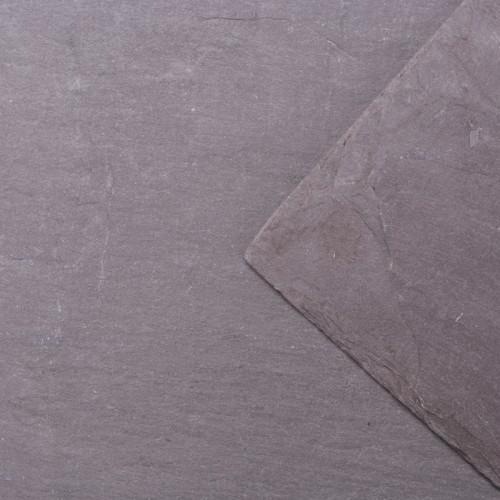
Here at UK Slate, we are specialist slate importers and exporters of natural slate from across the globe. We only source the very best globally and domestically thanks to our links to independent quarries, ensuring consistent and reliable supplies. We pride ourselves on our top-notch customer service and assure the very best support for you and your project.

You can browse our extensive range of slates on our website. Whether you’re looking or slate roof tiles, wall tiles or floor tiles, we will have something for you. Contact us today to find out more.
When you think about the roof of your home, the last thing you want to worry about is whether it will stand the test of time. However, not all roofs will last throughout your lifetime. If you’re moving into an older property that hasn’t had a new roof for decades, it might be something you need to consider sooner than later.
Old, damaged roofs can cause damp and mould to grow in your home and could eventually lead to roof collapse if left in a dire condition. So, it’s vital you know roughly how long your roof has got left before you need to think about maintenance or an entire replacement.
Here’s what you need to know.

The life of your roof can be impeded or improved by a number of factors, including:
The type of roofing material used is an especially important factor when determining the lifespan of your roof. Knowing which materials provide the longest lifespan can also help you make the best choice for roofing when you need to get a new one installed.
Asphalt is used to make roofing shingles and is a common roofing slates materials as is very affordable and easy to install. Asphalt roofing shingles are made from either paper fibre mats or fibreglass that has been impregnated with asphalt and coated with mineral granules.
These shingles can be expected to last from around 15 to 40 years, depending on the quality of materials chosen, the installation and the environment the roof is exposed to. You can maximise the lifespan of asphalt shingles by avoiding cheap shingles and keeping them clear of debris where possible.
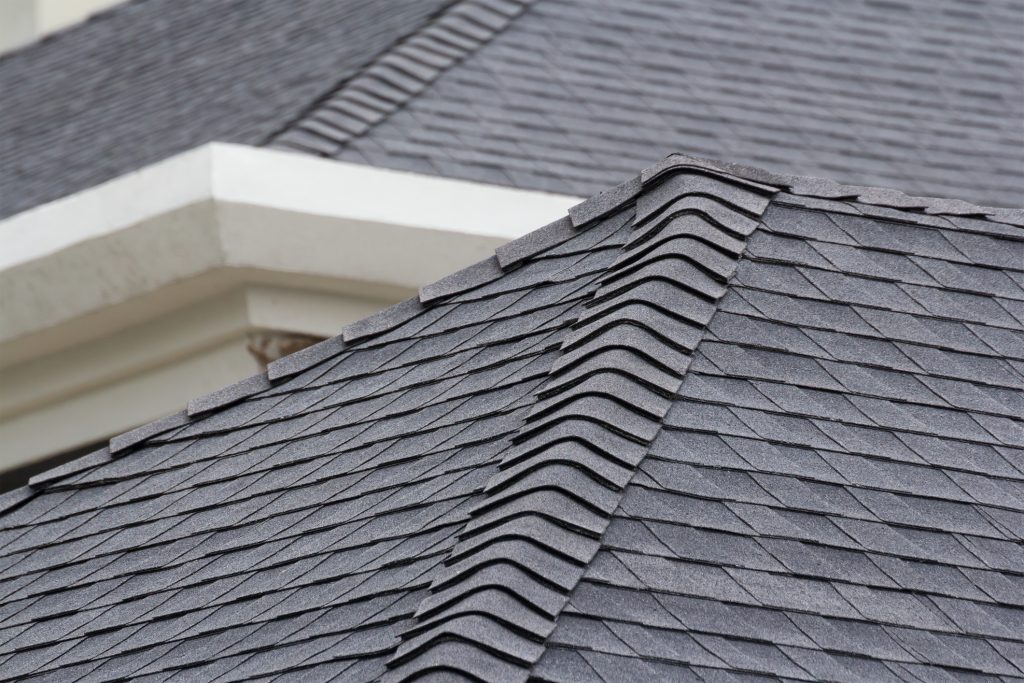
Metal roofing is a common option found in commercial, industrial, and agricultural buildings, but can also be used for housing. They are popular in areas prone to wildfire danger due to their resistance to fire damage.
Metal roofing often takes the form of roofing sheets that is laid in panels with the seams overlapping along the roof slope. These types of roofs are easy to maintain and are very durable against the elements. They have a lifespan of around 30 to 50 years, which puts it far ahead of asphalt shingles, although some homes may not be suitable for metal roofing. To increase their lifespan, they should be subjected to regular checks and maintenance to ensure the fasteners and sealants haven’t failed.

Traditional tiles are made from terracotta clay, but you can also get ceramic tiles made of fired clay. These are a popular choice due to their aesthetics, but they require sturdy roofing and framing to hold the weight.
When properly maintained, you could see clay roof tiles last for up to 100 years or more. These tiles are very hardwearing, but they are susceptible to cracks. When cracks occur, the damaged tiles should be replaced as soon as you spot them to prevent any damage from worsening.

Slate is a variation of a stone roof where the roof is covered with natural slate tiles that have been mined from quarries. Slate has a natural tendency to split into flat slabs, making it an ideal material to use for roofing. It can be more expensive than other roofing materials, but it is the most durable one of all and can last your home a lifetime.
Slate roofing tiles can easily last 100 years and far more, demonstrated by the fact that there still stand historical buildings dating back hundreds of years with their original slate roofs intact. Like the clay tiles, any broken slate tiles should be replaced as soon as possible to maintain the longevity of your roof.
Slate also has the advantage of looking truly beautiful, with the vast range of styles and the stunning natural colours that occur in the rock.
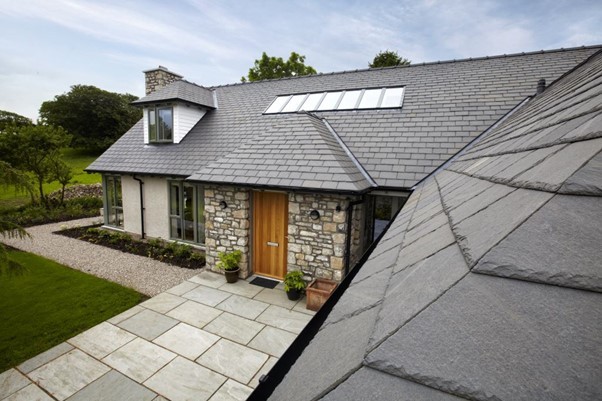
Slate is a popular material used for an array of designs for building construction, from roofing to flooring, to landscaping. As it is a natural material, slate is often hailed as one of the best materials to use in construction due to its abundance, heat-retaining properties and environmentally friendliness. Made from fine-grained metamorphic rock composed of sedimentary or volcanic ash deposits, it is a material which has been used for centuries.
Slate brings numerous benefits due to its remarkable durability and fire and water resistance, but what is it about slate that makes it so environmentally friendly?
As demand for slate has increased, suppliers have been opting to transport from abroad to source natural slates. There are various destinations around the world where natural roofing slates are transported to the UK, the most common being Spain, Brazil and China.
With this method, slates are transported via a 40-tonne articulated truck from the quarry to a designated port, where they are then shipped to the UK. Being transported via sea results in a cleaner and more efficient journey, reducing carbon emissions.
But there are also plenty of slate quarries in the UK, so they’re right on our doorstep, reducing the distance needed for transportation. At UK Slate, we are based on the edge of the Lake District, an area known for its high-quality slate. We can provide you with both UK quarried slate and slate from across the globe.
According to data from the Inventory of Carbon and Energy, which looks at the amount of energy and carbon in a building material, natural slate makes the least environmental impact. There is very little manufacturing in the slate collection process, as it is handcrafted work from the quarry.
It also produces the lowest embodied energy, the energy required for manufacturing, transportation and the use of the product and waste product. Slate has the lowest carbon footprint due to the fossil fuel used to process it.
Other materials have more complex manufacturing processes with a higher environmental impact. Ceramic tiles, for example, need high-temperature processes in furnaces, meaning they consume lots of energy that the slate process does not.
Slate tiles have a long life that can withstand adverse conditions like heat, rain and wind. With proper care and maintenance, slate roofing can last well over a hundred years. In fact, supporting timbers are more likely to deteriorate before the slate tiles themselves. Your slate roof can resist severe wear and tear and protect your home from the surroundings.
With such a long-lasting material for your home, you won’t have to worry about replacing your roof anytime soon, and you’ll lessen your environmental impact by using a material that doesn’t need frequent replacing.
Throughout all the stages of its life span, natural slate will remain environmentally friendly. Due to this, it has become one of the best natural choices for sustainable buildings. Below, we have listed some reasons as to why natural slate is the best ecological option:
By building a roof with natural slate material instead of fibre cement, it can avoid the creation of up to 6.2 tons of CO2 emissions. This is equivalent to the pollution created by an average car over 18,600 miles (30,000km).
There are numerous reasons and benefits which add up to natural slate being one of the most environmentally friendly materials used today. Here at UK Slate, we ensure we are constantly able to source the very best slate from around the globe. We pride ourselves on meeting and exceeding your expectations. With all our years of experience, we can source you the best slate domestically and from about the globe, and we offer national and international delivery so we can get to you wherever you are.
If you would like to know more about our products and services, get in touch with us today by calling 015395 59289 or emailing info@slate.uk.com and we will be happy to help.
Slate is a versatile stone that is available in a number of different finishes including riven, honed, antiqued and tumbled to name a few. Although often a little more expensive than alternative flooring, it’s considered to be a worthwhile investment thanks to its exceptionally robust properties.
There is something beautiful and unique about slate flooring that other types of flooring simply cannot compare to. Available in a wide range of different colours, sizes and finishes, slate has become a staple in many homes and businesses across the UK thanks to its flexibility and versatility.
A lot of home and business owners choose slate because it’s durable and requires little maintenance – but this doesn’t mean that you can completely ignore it! To keep your slate floor looking bright and fresh, you do need to keep on top of maintenance, so we have put together an article looking at how to maintain and prolong your natural slate flooring for the long-term.
The most obvious way to keep your floor clean would be to not get it too dirty in the first place. However, we know that this isn’t always possible, so it’s essential that you take the right steps to protect it as much as possible and this is where sealing becomes extremely important!
Slate and all natural stone must be sealed with an impregnator in order to prevent staining. Although naturally very impermeable and smooth, on a microscopic level slate still has a grainy texture which will otherwise allow liquids to be absorbed. There are a variety of sealants available which can alter the appearance of your flooring, some intensifying the colours, others producing a glossy sheen.
Whilst slate floors are low-maintenance, if you’re looking to keep them in the best condition you can for the foreseeable future, we would recommend implementing a weekly care routine for your new flooring.
As a general rule of thumb, you should always try to sweep your slate flooring at least twice a week, especially in the months following installation. This is mainly down to a process that can occur called ‘spalling’ which essentially means that small pieces of the material may flake off the surface; it’s worth noting this is completely normal and will usually stop around 6 months to a year after installation.
Mopping your slate tile floor is a must on a weekly basis, and we would recommend doing so with a gentle cleanser where possible. You should always use a cleaning product that is specifically made to wash natural stone, rinse with water and then let it air-dry.
The importance of regular cleaning of your slate floor cannot be understated. When it comes to cleaning we’d recommend Lithofin Easy Care Cleaner as this is designed to work in partnership with the sealants in order to prolong their lifespan. For more stubborn dirt and stains, a stronger cleaner may be required such as Lithofin Power Clean or Wexa Multi Purpose Remover.
Where possible, you should also avoid using tough scrubbing brushes that may scratch and damage the flooring and sealant. If cared for correctly, slate flooring should last you an entire lifetime!
The team here at Slate UK have put their heads together to come up with a quickfire do’s and don’ts list for slate flooring, so always do:
And don’t:
If you would like to speak to us about the range of floor slates that we have available, please don’t hesitate to contact us. You can give us a call on 015395 59289 and we will be more than happy to help you out.
Have you ever found yourself wondering just how slate makes its way from a quarry to your home? There are actually five distinct steps that are taken during the process, and each of them is vital to ensuring that you end up with a robust material to adorn your roof, house or garden.
In this article, we will take a closer look at each of the steps taken to prepare slate for your home, whilst also delving deeper into the background of slate as a material.
Before we get into the five steps taken to get slate from the quarry to your home, we thought we would give you some background on the material.
A metamorphic rock, slate is derived from the process of metamorphism from clay or volcanic ash. It is the finest grained form of metamorphic rock. Although the majority of slate in Europe comes from Spain, there are actually many UK quarries, with Wales and Cumbria forming the main source of the material on our shores.
Slate is not only perfect for use in roofing tiles, it’s also an ideal material for flooring too. This is mainly down to its characteristics as a naturally slip-resistant floor, making it ideal for wet areas of the home such as the bathroom or outdoor areas.
Firstly, the slate needs to be extracted from the quarry. This involves finding a vein of stone suitable for a particular use before harvesting the slate.
Once the quarry is discovered by a team of experts, they strategically extract the slate by using a variety of methods. This could be by blasting, wire cutting or circular saw cutting the material. Slate must be quarried with precision, as the extraction process can affect the integrity and yield of the slate. The blocks that are extracted on site are left in the largest possible size for transportation; this is done in order to prevent material loss during transport. After evaluating the stone, experts will then cut the slate into more manageable pieces before moving onto the next step.
Radial saws will cut the slate into appropriate shapes and sizes in two stages. First to the correct width and then to the desired length.
The blades used to cut the slate are diamond tipped for precision. Diamond is the hardest material known to man, meaning there’s little on the planet that it is not capable of cutting. It’s fair to say that each of these blades is extremely costly but essential to producing accurately cut pieces of slate for sale.
Splitting is considered to be one of the most specialised skills within slate production. Each piece which was cut during the last stage is split by hand from the blocks created. The expert will split the block into separate pieces, halving the thickness until they reach the final product. Due to the delicacy of the material and this process, a lot of the slate is damaged, with 85% of the slate being unusable or spoiled.
Once the slate is split, the rives (the split slate with sawn edges) will go for dressing.
This step is also where any other aesthetic details will be carried out, such as shaping into Schuppen slates for more decorative laying.
Roofing slates are often pre-holed at the quarry for the slater’s convenience. They are usually drilled in small groups or even one by one. All slate should be holed from the bed of the material (the underside) using a punch or boring method. This is a particularly delicate stage of the process, and if care is not taken then damage can be caused to the slate.
Occasionally you will find a slate un-holed, or with just one hole in the material; this can happen when a group of slates are particularly thick, and the drill piece is not long enough to reach the entire way through the pile.
The final stage before your slate is ready for shipping is packing, which sees every pallet from the factory being packed by hand in order to ensure minimal breakages or damage to the product. The slates are packed tightly on end so that the slate doesn’t move and shatter during transportation. Slate can break relatively easily, so it’s absolutely essential that care is taken during the packing stage, as any issues can cause the product to break. During this process, the wooden crates that are used to transport the slate are also treated with heat, and formally Methyl Bromide up until 2010, to kill any insects or parasites in the wood to prevent the spread of diseases and introduction of foreign species.
UK Slate stock a range of roofing slates which are sourced from only the finest quarries around the world. From our years of experience, we know that our slates exceed the expectations. If you would like to know any more information about our superb slate, simply get in touch with us today. You can call us directly on 01539 559289 or email our team on info@slate.uk.com and we will be more than happy to assist you further.
The roof is one of the most crucial and yet vulnerable parts of the home. It may not be something you think about very often or pay much attention to, but a well maintained, looked after roof is crucial to having a leak-free home. Here in the UK with our torrential weather for most of the year, no UK household can afford to skimp on quality roof maintenance and repair.
A good roof shouldn’t cause problems and should last for a very long time, but it’s paramount that you stay vigilant for any signs of problems. The sooner you can get a roof problem sorted, the less damage it will cause. Here are some of the ways your roof could be letting you know there’s a problem.
Water damage can often be mistaken for damp, but make no mistake, if you’re getting ceiling stains the cause is likely a leaky roof. Even the smallest watermarks could mean that water is seeping in from your roof, usually due to a hole or crack.
Water can do some real damage to your roof; even a tiny leak could lead to big problems such as mould, rotting, damaged ceilings and even roofing collapses. If you spy any water damage in your home and you suspect the roof to be the cause, getting it sorted as soon as possible will help prevent more catastrophic damage.
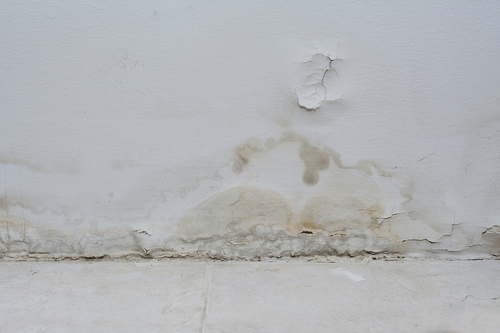
Aside from the mould that water damage can cause inside the home, mould and moss on the roof’s exterior can cause big problems. Roof tiles can be forced apart by moss, creating a gap that allows rainwater to seep in, which in turn will lead to water damage. Whole slates can also be broken apart as a result of freeze-fore weathering during winter as moisture can penetrate the slate via plant root systems before freezing. If you allow mould and moss to fester, it’ll create more problems down the line. Nip it in the bud early; you can use a chemical treatment to take care of moss, or if you’re planning a roof replacement, consider materials that are algae resistant.
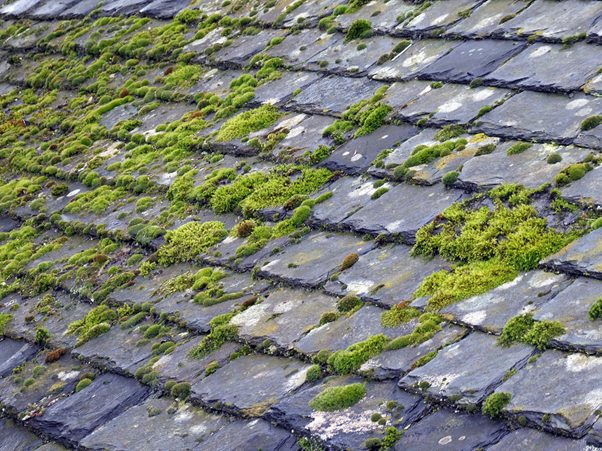
When you check your roof for damage, examine whether you have any loose or damaged, or even missing, roof tiles. These are typically a result of wind damage, but fortunately they can usually be easily replaced with a Hall Hook Slate Repair Fixing. This is best done quickly, as missing roof tiles expose the house to defects that can lead to massive deterioration of the entire roof.
However, if most of your roof tiles are looking worn and worse for wear, why not consider an entire roof replacement? At UK Slate, we can provide you with high-quality sourced roofing slate from the finest quarries around the globe.

If the water damage hasn’t made it down yet into the central part of the house, that doesn’t necessarily mean there isn’t a problem. The attic should be the first place you check, as any leaks in the attic such as circular stains on the walls can be a sign that water is getting in. Attic leaks are often caused by missing tiles, broken seals or even condensation build up. Make sure you address these problems as soon as you notice them. It’s worth doing an annual roof check which includes going into the attic and inspecting the walls for any moisture. A good quality breathable membrane should always be used under slates to allow damp air to ventilate through the roof before costly damage is caused.
While gutters are known to catch leaves, twigs and other kinds of nature’s debris that often needs to be cleaned away, clogged gutters could also be a sign of a deteriorating roof. If you notice sand, sludge-like granules or even rust in the gutters, it could be a sign that your roof covering is deteriorating. A few loose granules are normal as your roof naturally ages, but if there is an increase in this residue, it could be a sign that the tiles are deteriorating faster than they should.
Perhaps the most significant warning sign of a severe problem, a droopy roof is an indication of a structural integrity problem with the house. The sagging could be caused by frequent exposure to moisture, faulty roofing materials during building, improper installation or in locations that experience frequent bouts of snow and ice. If your roof appears to be sagging, have this look at by a professional immediately, or it could lead to a roof collapse.
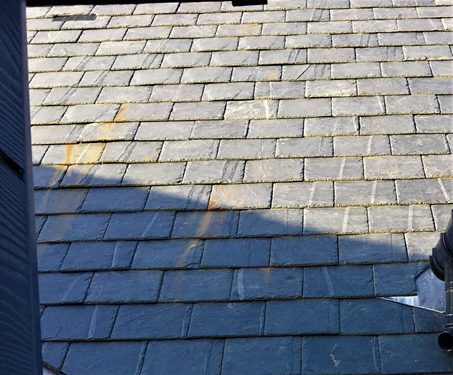
Perhaps not something you may have considered, but if you’ve noticed a spike in your energy bills, it could be because you’ve had to start cranking the heating up higher than usual to keep warm. A roof can seriously contribute to maintaining a toasty temperature with its insulation properties. So a colder home could be the result of a faulty roof or ventilation problems causing the temperature to drop.
At UK Slate, we can provide you with a fantastic range of slate roof tiles to give your roof a brand-new lease on life. Contact us today for more information.
When installing a roof, the wide variety of materials to choose from can be overwhelming. Knowing which kind of tiles are best to invest in for a beautiful and durable roof is essential. Slate roofing tiles are one of the most high-quality and long-lasting roofing tiles around, yet durability is just one of the many benefits a slate roof may bring to your project. Here’s a look at some of the reasons slate makes a great choice for roofing tiles:
When properly maintained, slate roofs can last for decades, even centuries. Naturally strong, and absorbing little water, slate roofs are less susceptible to leaking and frost damage than other, less durable materials.
Here at UK Slate, we supply only those slates which attain the A1, T1 and S1 BSEN standards for water absorption, carbon content, and thermal cycling. Our Estillo 29 slate, for example, tested just 0.29% for water absorption. This means that when you buy from UK Slate, you can be confident that your roof will stand strong whatever the weather.
From time to time, prolonged extreme weather and general old age can leave a building looking tired and neglected. But once the slate tiles have been carefully removed and tidied up, they can often be re-laid to provide a home with decades more protection from the elements.

Here at UK Slate, we believe you shouldn’t have to choose between beauty and durability. As well as being hard-wearing, slate tiles have a beautiful, classic, rustic look, undiminished by time or the elements.
When using slate, you have plenty of options to customise your roof in both size and colour. Not all slates are grey, they actually come in a range of colours, from the gentle green of our Elterdale, to the deep purples of Welsh Heather Blue. There is plenty to choose from when roofing with slate. Whether you wish to blend in with the colour tradition of your local area or make a statement with a more striking hue, slate tiles are the ideal material to achieve the desired aesthetic and provide an elegant finish to your project.
With a long-established pedigree as a roofing material, slate tiles remain the go-to for more traditional builds such as vintage homes, and historical restorations. Yet much of the beauty of working with slate comes in its versatility, as slate tiles can achieve stunning results atop more modern, innovative projects. The limit truly is your imagination.
But the colour of the slate is not the only factor to consider when choosing your slate. For centuries, slates have been cut into a variety of shapes for more decorative and prestigious markets.

Slate is very resistant to fire, able to withstand higher temperatures than many metals can. It’s great for enduring severe temperature changes, which is why it makes an ideal choice for the likes of roofs and floors. It’s why it also makes a great choice for the kitchen, due to its resistance to heat and burning. Slate slabs that are designed to be used as counter tops in kitchens are chosen for their ability to withstand the level of heat it may come across in typical kitchen conditions.
Slate forms naturally when layers of rock are exposed to extreme pressure and heat, so it’s no surprise that it’s so resistant to fire. This natural property makes slate a great choice for roofing material as it reduces the chances of a building’s roof catching alight in the event of a fire.

Waste from roofing is a substantial part of the total waste sent to landfills each year. Asphalt shingle roofing, for example, needs replacing every couple of decades. Waste is reduced substantially by choosing slate, due to its greater life-span. Choosing slate is a sustainable solution to ever-more prevalent environmental concerns, allowing you to rest-assured that your roof, while meeting your needs, does not do so at the expense of the environment.
Here at UK Slate, supplying quality natural slate roofing and excellent customer service to every client is our priority. If you require high-quality tiles for your roof, and want to know how we can help you, you can contact us on 015395 59289 to speak with our highly-skilled team and they will happily answer any query you may have.
This interactive tool considers key specifications such as shape, material, dimensions, and finishing details to generate a personalised quote tailored to your needs. We offer a wide range of shape options, from classic rectangular designs to sleek, modern curves, all crafted from luxurious, high-grade slate.
This interactive tool considers key specifications such as shape, material, dimensions, and finishing details to generate a personalised quote tailored to your needs. We offer a wide range of shape options, from classic rectangular designs to sleek, modern curves, all crafted from luxurious, high-grade slate.